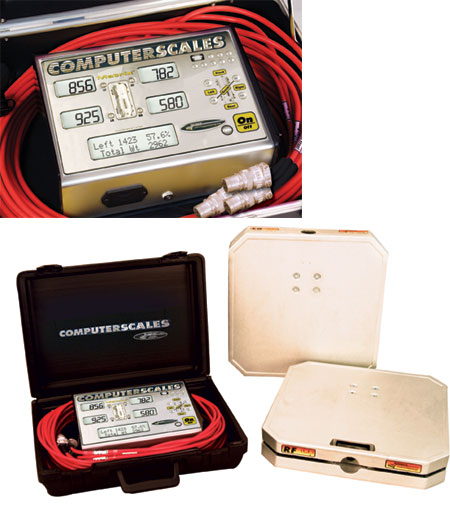Getting into Balance: Corner Balance Basics
In the world of automotive performance, the term “corner balance” is one that is often used but seldom understood. It is a further derivative of weight distribution and refers to the amount of weight or force that each individual wheel exerts on the road. By “corner balancing”, one shifts the weight carried by each wheel towards the optimal value for that car.

At the most basic level, think of your car as a table with four legs. If the table top is 100 pounds and perfectly balanced, each leg holds 25 pounds—or exerts 25 lbs of force on the floor. Now let’s extend one leg, say the left front. All of a sudden that one extended left front leg and the leg at the opposite corner, or the right rear leg, are carrying 50 pounds each. The table will teeter on those two legs. The key to this example is to understand the relationship between the legs. In other words when you adjust a leg, the opposite corner leg is affected.
Since a car has a suspension and not stiff legs, the load is not transferred so absolutely, but it is transferred nonetheless.
The basic equations for corner balance are as follows:
fig 1) LF/LR = RF/RR -or- fig 2) LF + RR = RF + LR
Where
LF = left front
LR = left rear
RF = right front
RR = right rear
The goal of corner balancing is to have equal front to rear weight ratios (fig 1) for both the left and right sides.
Street cars are less susceptible to corner imbalance since they run springs that are relatively soft. Performance and race cars that run spring rates higher than 300 lbs/in really benefit the most from a properly aligned and balanced suspension (think back to the stiff legs of a table example above).
In order to adjust the corner balance of a car, we need to be able to adjust the corners individually by raising or lowering the spring height (and to a lesser degree tire pressure—but that’s a whole other topic). This can only be done using adjustable spring perches such as are found on coil-over suspensions. And you thought that the fancy coil-over kit you bought was only good for ride height!
The process to corner balance a car takes a bit of trial and error. The first step is to get some initial corner weights and plug the numbers into the corner balance equation. The actual corner balance will never be as perfect as the above examples, but there are acceptable ranges. Starting with the initial readings the technician will adjust the spring heights and re-measure the corner weights, fine tune, re-measure… until the equation gets into that acceptable range. This can be a long and tedious operation, but for the track enthusiast or race car driver it is worth the effort. A properly balanced car will handle the same in left and right corners and the tire contact patches will be maximized at all four corners. The car will be more predictable and simply easier to handle.
If you have a height adjustable suspension, it only makes sense to have the car corner balanced.
Comments
Hi Horst,
Great write up...one of the few that makes it easy to understand. What kind of cost is typical for the average corner weight job? I have just got a set of KW V3 for my 135 and would love to come in for a alignment and corner weight.
Posted by: Clayton | November 18, 2008 08:01 PM